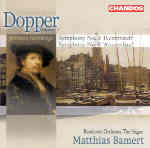Chandos’ first disc of orchestral music by Cornelis Dopper was very enjoyable, but this is better still. The Third Symphony, subtitled “Rembrandt” (apparently for no particular reason), enjoys the virtue of brevity. Composed in 1904/05, its opening may remind listeners of Elgar, and it’s every bit as good: stately, a bit foursquare, rich strings backed by harp. However, once the allegro gets going there’s no looking back as Bamert and his orchestra attack the music with unbridled gusto. The Andante features some gorgeous writing for solo winds backed by harp; the scherzo is an earthy sort of country dance; and the finale, though it ends triumphantly, spends most of its time exploring surprisingly delicate, nocturnal moods, with particularly Romantic soft brass fanfares echoing through the texture. It’s all over in 29 very pleasant minutes.
A touch longer, the “Amersterdam” Symphony (1912) by rights should be as popular as Vaughan Williams’ “A London Symphony”. Here Dopper has left behind what few German-school inhibitions still touched his symphonic writing, and has set himself free. His harmonic palette has widened to include modal and “impressionistic” elements; his scoring (always expert) now includes far more independent use of brass, winds, and percussion. The very opening, with its prominent celesta in the texture, demonstrates his new sensitivity to orchestral color. This is a masterpiece that clearly belongs in the active repertoire today.
Unlike the Third, which began with a lengthy slow introduction, this symphony takes off like a shot, the first movement being a study in waltz rhythm, sometimes bold, sometimes pensive. The stunning Adagio begins contemplatively and then expands in Mahlerian fashion to include highly colorful episodes in different tempos, culminating in a huge climax capped by tremendous organ chords. In the percussion-led scherzo, it almost seems as if the Bacchanal from Samson and Delilah wandered north: a wild dance twice alternates with a softer trio section, returning with renewed ferocity each time. Cleverly spaced pauses keep the listener guessing what will happen next.
The finale, with its significant solo role for tubular chimes, takes on the characteristics of an almost Ivesian collage, with episodes in wildly differing styles always interrupted by the pregnant sound of the bells. After a few calm moments, it all leads to a hugely triumphant coda that sets the seal on one of the most exhilarating and purely lovable orchestral works to come along in quite some time.
As with the Third Symphony, Matthias Bamert and the Residentie Orchestra of The Hague play the music with exceptional virtuosity and enthusiasm yet also show great sensitivity to the music’s numerous delicately scored passages. The recording sounds marvelous: play that organ-capped climax of the second movement for your audiophile friends! Dopper wrote seven symphonies in all, and getting the remaining four onto disc ought to be a major priority.
































